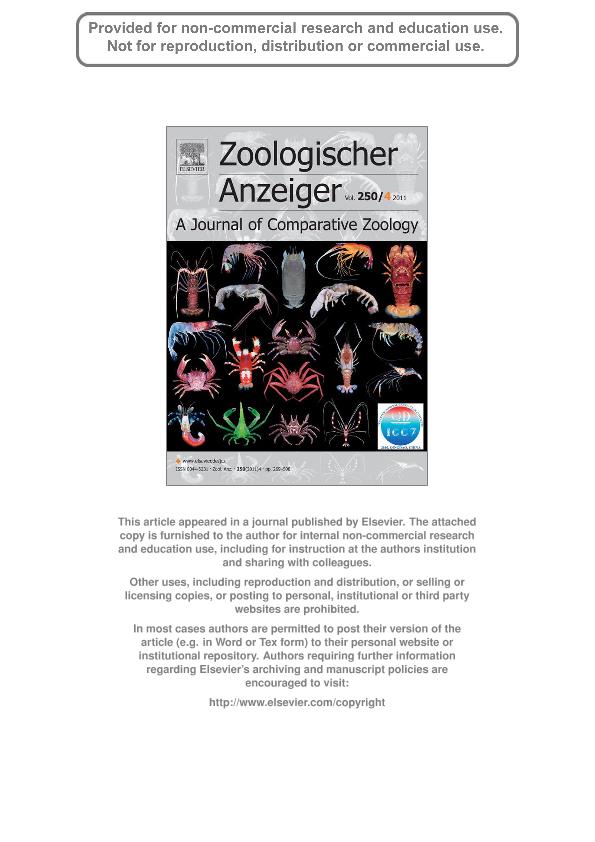Mostrar el registro sencillo del ítem
dc.contributor.author
McLay, Colin L.
dc.contributor.author
Lopez, Laura Susana

dc.date.available
2019-01-18T18:36:58Z
dc.date.issued
2011-10
dc.identifier.citation
McLay, Colin L.; Lopez, Laura Susana; A hypothesis about the origin of sperm storage in the Eubrachyura, the effects of seminal receptacle structure on mating strategies and the evolution of crab diversity: How did a race to be first become a race to be last?; Elsevier Gmbh; Zoologischer Anzeiger; 250; 4; 10-2011; 378-406
dc.identifier.issn
0044-5231
dc.identifier.uri
http://hdl.handle.net/11336/68262
dc.description.abstract
The origins and evolution of sperm storage in Brachyura are enigmatic: sperm is either stored in seminal receptacles, accessible via the vulvae on the sixth thoracic sternite, or in spermathecae at the border between the seventh and eighth sternites. Crabs with spermathecae are collectively referred to as "podotremes" while crabs with seminal receptacles belong to the Eubrachyura. The position of gonopores is the primary basis for subdividing the Eurachyura into the Heterotremata (female vulvae + males with coxal gonopores) and Thoracotremata (female vulvae + males with sternal gonopores). We present a hypothesis about the evolution of seminal receptacles in eubrachyuran female crabs and argue that the sternal gonopore has been internalized into chitin-lined seminal receptacles and the vulva is in fact a secondary aperture. The loss of some or all of the ancestral chitinous seminal receptacle lining was linked to ventral migration of the oviduct connection. Male and female strategies are to maximize gamete fertilization. The most important variable for females is sperm supply, enhanced by long-term storage made possible by the seminal receptacle. To maximize their fertilization rates males must adapt to the structure of the seminal receptacle to ensure that their sperm are close to the oviduct entrance. The major evolutionary impetus for female mating strategies was derived from the consequences of better sperm conservation and the structure of the seminal receptacle. The advantages were all to the females because their promiscuity and sperm storage allowed them to produce more genetically variable offspring, thereby enhancing variation upon which natural selection could act. We extend our arguments to Brachyura as a whole and offer a unifying explanation of the evolution of seminal receptacles, comparing them with the spermathecae found in "Podotremata": they were independent solutions to the same problem: maintaining sperm supply during evolutionary carcinization. Explanation of eubrachyuran mating strategies requires analysis of the mating-moulting link, indeterminate vs. determinate growth format and seminal receptacle structure. Two alternatives for each of these characters means that there are eight possible outcomes. Six of these outcomes have been realized, which we term Portunoid, Majoid, Eriphoid, Xanthoid, Cancroid, and Grapsoid-Ocypodoid strategies, respectively. Mapping these characters on to a workable phylogeny (wherein some changes to the seminal receptacle + moulting-mating links are assumed to have occurred more than once) produces the following relationships: Portunoids + Majoids are a sister group to the rest of the Eubrachyura, which fall into two sister groups, Eriphoids + Xanthoids and Cancroids + Grapsoid-Ocypodoids and the "Podotremata" is sister group to all the Eubrachyura. We conclude that what began as a race to be the first to mate was turned on its head to become a race to be last, by the evolutionary changes to the seminal receptacle. Eubrachyuran females were advantaged by greater reproductive autonomy, more opportunity to mate with other males, resulting in more genetically variable progeny and leading to the evolution of much greater taxonomic diversity compared to "podotremes".
dc.format
application/pdf
dc.language.iso
eng
dc.publisher
Elsevier Gmbh

dc.rights
info:eu-repo/semantics/openAccess
dc.rights.uri
https://creativecommons.org/licenses/by-nc-nd/2.5/ar/
dc.subject
Brachyura
dc.subject
Carzinization
dc.subject
Copulation
dc.subject
Crustacea
dc.subject
Decapoda
dc.subject
Evolution
dc.subject
Fertilization
dc.subject
Growth Format
dc.subject
Mate Guarding
dc.subject
Moulting
dc.subject
Podotremata
dc.subject
Seminal Receptacle
dc.subject
Sperm Competition
dc.subject
Sperm Storage
dc.subject
Sperm Transfer
dc.subject
Spermatheca
dc.subject.classification
Otras Ciencias Biológicas

dc.subject.classification
Ciencias Biológicas

dc.subject.classification
CIENCIAS NATURALES Y EXACTAS

dc.title
A hypothesis about the origin of sperm storage in the Eubrachyura, the effects of seminal receptacle structure on mating strategies and the evolution of crab diversity: How did a race to be first become a race to be last?
dc.type
info:eu-repo/semantics/article
dc.type
info:ar-repo/semantics/artículo
dc.type
info:eu-repo/semantics/publishedVersion
dc.date.updated
2019-01-17T13:57:41Z
dc.journal.volume
250
dc.journal.number
4
dc.journal.pagination
378-406
dc.journal.pais
Alemania

dc.description.fil
Fil: McLay, Colin L.. University Of Canterbury; Nueva Zelanda
dc.description.fil
Fil: Lopez, Laura Susana. Universidad de Buenos Aires. Facultad de Ciencias Exactas y Naturales. Departamento de Biodiversidad y Biología Experimental; Argentina. Consejo Nacional de Investigaciones Científicas y Técnicas; Argentina
dc.journal.title
Zoologischer Anzeiger

dc.relation.alternativeid
info:eu-repo/semantics/altIdentifier/doi/http://dx.doi.org/10.1016/j.jcz.2011.06.002
dc.relation.alternativeid
info:eu-repo/semantics/altIdentifier/url/https://www.sciencedirect.com/science/article/pii/S0044523111000453
Archivos asociados
